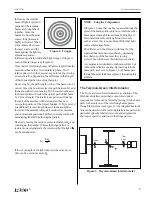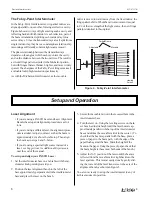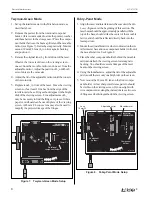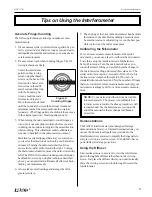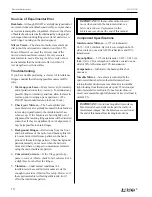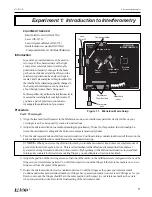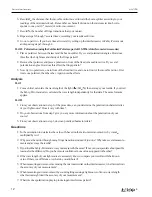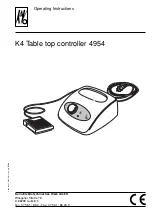
17
012-07137B
Precision Interferometer
®
Twyman-Green—
Twyman-Green operation gives students a quick, qualita-
tive look at how interferometry can be used to test optical
components. See
Twyman-Green Mode
in the
Setup and
Operation
section of the manual.
Any distortion of the circular fringe pattern is due to
spherical aberration from the test lens. Turn the lens until
it sits at various angles to the optical path and watch the
fringe pattern change. Distortion here is due partially to
astigmatism from the lens.
Spectral Light Fringes—
Although interferometry is easiest with a laser light source,
measurements can be made successfully using any mono-
chromatic source of sufficient brightness. However, if a
laser is not used, it is generally not possible to project the
interference fringes onto a screen. Instead, the fringes are
viewed by looking into the beam-splitter (or into the
movable mirror in Fabry-Perot mode).
If you use a spectral light source with spectral lines at
several different frequencies, it may be necessary to use a
filter that blocks all but one of the spectral wavelengths.
Michelson Mode:
➤
➤
➤
➤
➤
NOTE:
One difficulty when using a non-laser light source in
Michelson mode is that the coherence length of the
light is far less with a non-laser source. Because of
this, the compensator should be used. It mounts
magnetically on the back of the beam-splitter (the
side opposite the thumbscrew).
It's also important that the optical paths of the two
interfering beams should be nearly equal. To ensure
that this is the case, set up the interferometer with a
laser (if you have one) and adjust the movable
mirror position until the fewest possible fringes
appear on the screen. (Theoretically, when the beam
paths are exactly equal, one big maximum should
appear that occupies the whole screen. But this is
usually not possible to achieve in practice due to
optical imperfections.) Then remove the viewing
screen and replace the laser with the spectral light
source. If fringes aren't visible when looking into the
beam-splitter, proceed as follows:
a. Tape two thin pieces of wire or thread to the surface of
the diffuser to form cross-hairs.
b. Place the diffuser between the light source and the
beam-splitter.
c. Adjust the angle of the beam-splitter so that, when look-
ing into the beam-splitter, you can see two images of
the cross-hairs.
d. Adjust the tilt of the fixed mirror until the cross-hairs are
superimposed. You should be able to see the fringe pat-
tern.
Fabry-Perot mode:
a. Tape two thin pieces of wire or thread to the surface of
the diffuser to form cross-hairs.
b. Set up the equipment in Fabry-Perot mode, and place
the diffuser between the light source and the fixed mir-
ror.
c. Look into the movable mirror from behind. Adjust the
tilt of the fixed mirror until the cross-hairs are superim-
posed. You should be able to see the fringe pattern.
White Light Fringes—
With careful alignment, the interferometer will produce
fringes from multi-chromatic or even white light . The
procedure is the same as for any non-laser source, as
described above. However, since it is harder to get a visible
interference pattern, it is strongly recommended that you
first set up the interferometer using a laser. Then substitute
your white light source.
Use a Photometer—
Use a photometer, such as PASCO Model OS-9152B, to
scan the fringe patterns. You can compare the intensity
distributions in the Michelson and Fabry-Perot modes. Or
use it to more accurately determine polarization effects. Or
just use it as an aid in counting fringes.
Heat Distribution in Air—
With the interferometer in Michelson mode, strike a match
and bring it close to one of the optical paths. Note the
distortions in the fringe pattern. For a more quantitative
approach, you could construct an air tight cell, and heat the
contents to observe the effects of heat on the index of
refraction of air.
Suggestions for Additional Experiments



